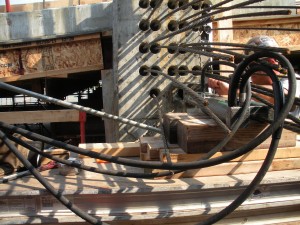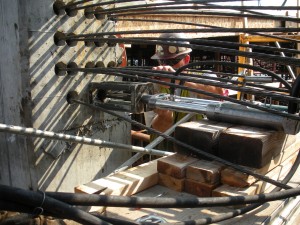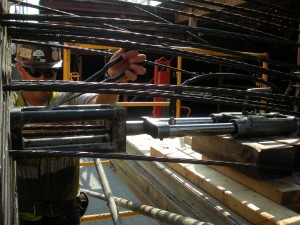On rare occasions, the ironworker/installer will need to detension an already-stressed post tensioning tendon. The reason may be due to a repair procedure or re-stressing due to out-of-range elongation readings.
Recommendations:
- During the detensioning process, the post-tensioning tendon will have to be “over-stressed.” The PTI Field Manual recommends that the hydraulic jack and pump gauge pressure should not be taken more than 5% over the normal stressing gauge pressure (at 33 kips of 0.5? tendon).
- The jack should be opened at least 4 inches so that it does not get “hung up” in case the wedges fail.
- The detensioning procedure be performed shortly after the normal stressing operation. Over time, the wedges deformed inside the anchor cavity and form a “lock” with the strand and anchor. (Refer to the PTI Field Manual 3rd Edition section 10.9).
The pictures below show an example of how to detension the tendons with a Detensioning Tool.

Place detensioning tool level with anchor cavity and strand. Secure hydraulic jack behind detensioning tool.

Extend Hydraulic Jack to unseat wedges. This follows the normal stressing procedure. Hold gauge pressure at 5% overstress.
Failure to use the proper parts or equipment could result in damaging the anchor, strand, equipment or harming the operator/by-standers. This procedure should be carried out by a Post-Tensioning Institute Certified Ironworker (level 2). This post is not a complete procedure for detensioning PT tendons. Proper jobsite precautions should be taken to restrict personnel during stressing and detensioning processes.
– Neel Khosa, Vice President, AMSYSCO
____________________________________________
Copyright © 2011 by AMSYSCO, Inc. All rights reserved.











